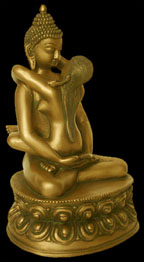The father mother symbolism ("yab yum") is not an example of
erotic art but is considered by the devout to be a manifestation
of the Buddha's highest spiritual essence. It is concrete evidence
presented in a most striking and graphic manner of the existence
of enlightenment, denoting the highest stage of yoga in which
there is no polarity, no discrimination and the truth is
indivisible. There in meditation in the presence of this artistic revelation, one
can discover infinite bliss and ultimate
self-realization.
The feminine symbol (mother) represents transcendent wisdom, the
direct awareness of reality as experienced and taught by the
Buddha. The masculine (father) represents compassion for all
beings which is the natural expression of such wisdom. Their
sacred union is believed to generate waves of bliss and harmony,
turning the world into a mandala and showering a rain of nectar
that satisfies the spiritual hunger in the hearts of humankind.
Today, statues and paintings of "yab yums" are sought by
collectors and boldly displayed in museums, while traditionally in
Tibet they were created and meant to be seen by only the
initiated. The arcane rituals associated with their display were
also not for public consumption. Modern depth psychology has
recognized that this imagery represents the deepest archetypes of
the unconscious, integrating powerful instinctual energies of life
into a consciously sublimated and exalted state. As a result, we
are fascinated by this beautiful art form, wanting to possess it whether
we are Tantric Buddhists or not!
On a final note, Tantra itself is derived from the verbal root tan,
meaning to weave. Many things are interwoven on the Tantric path,
including the lives of men and women. The Buddha couples of
Tantric iconography celebrate the profound harmony of the sexes and
the creation of partnerships devoted to the realization of the
ultimate truth.



